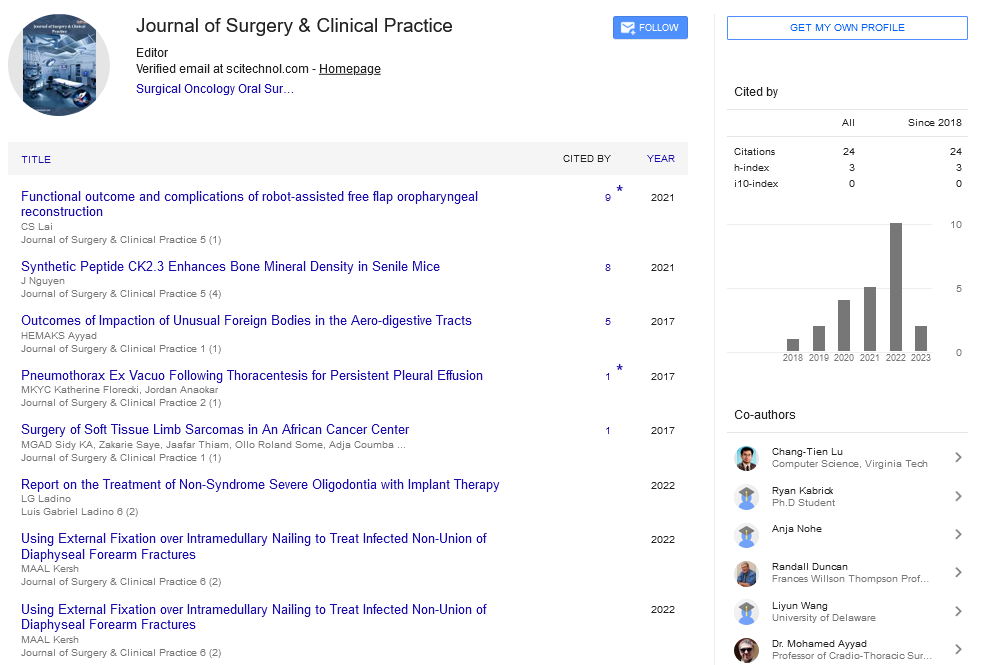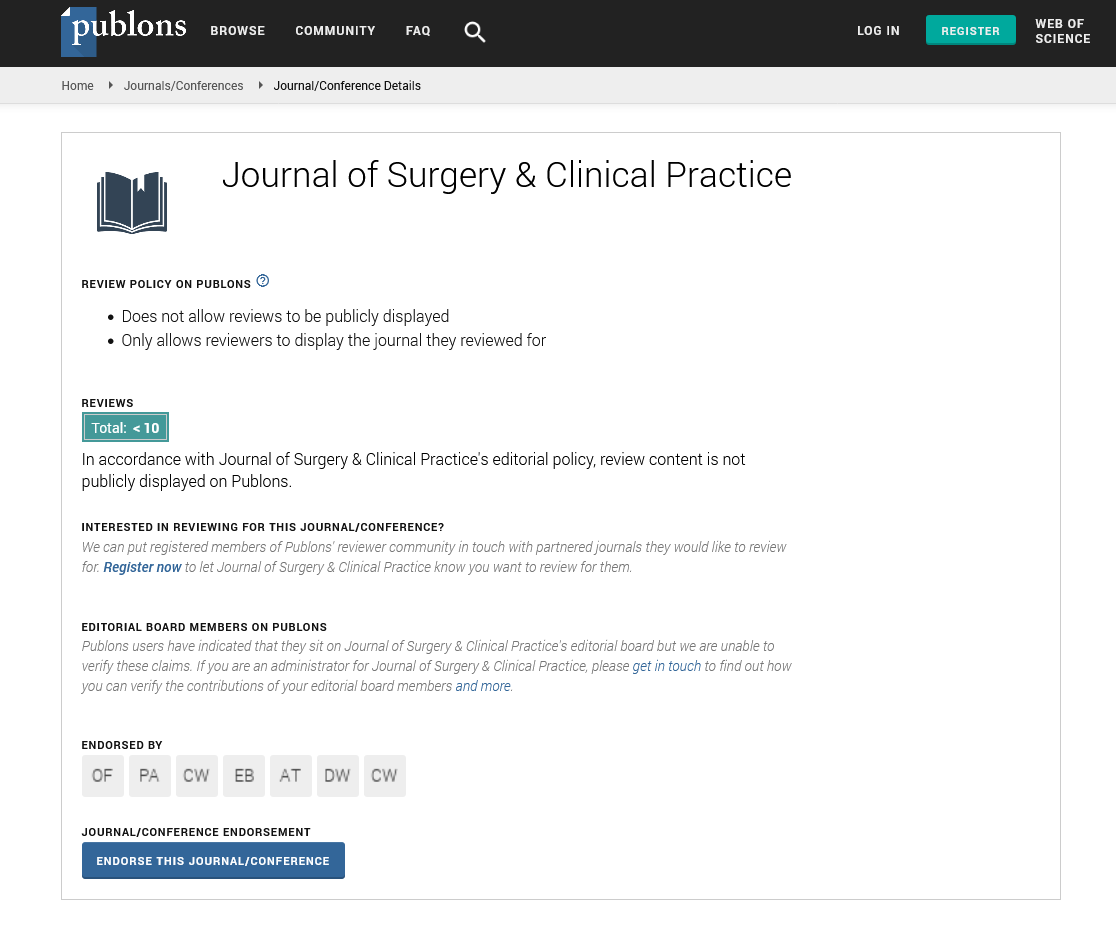Perspective, J Surg Clin Prac Vol: 6 Issue: 3
Neurosurgery a Novel Learning Platform
Rosebella Onyango*
Department of Public Health, Maseno University, Maseno, Kenya
*Corresponding Author: Rosebella Onyango
Department of Public Health, Maseno University, Maseno, Kenya
Email: onyangor56@gmail.com
Received date: 18 April, 2022; Manuscript No. JSCP-22-42522;
Editor assigned date: 20 April, 2022; PreQC No. JSCP-22-42522 (PQ);
Reviewed date: 29 April, 2022; QC No. JSCP-22-42522;
Revised date: 09 May, 2022; Manuscript No. JSCP-22-42522 (R);
Published date: 19 May, 2022; DOI: 10.4172/Jscp.1000362
Citation: Onyango R (2022) Neurosurgery a Novel Learning Platform. J Surg Clin Prac 6:3.
Keywords: Neurosurgery
Description
After birth, babies infected with mortal Immunodeficiency contagion or not are always at threat if Exclusive Bone Feeding (EBF) isn't exercise since mama’s milk is the ultimate nutrition for child’s survival, growth and development. Also, EBF of child for the first six months can reduce the morbidity and mortality of children especially in developing counties where poverty is high. In regions where HIV frequency is on the increase, especially in sub-Saharan Africa, EBF has the eventuality of reducing the threat Of Mama-to- Child Transmission (MTCT) of HIV.
According to World Health Organization (WHO), EBF situations are low in third world than the stated figure of 90 despite major coffers being set away for PMTCT comforting to increase the frequency of EBF. Still, in Kenya for illustration, the area with the most conceded Comprehensive Care Conventions (CCCs) is the North Rift with roughly 35 frequency of exclusive breastfeeding. The present study stressed the predictors of exclusive bone feeding among HIV-positive maters in Kenya. A descriptive cross-sectional study design was used on a sample of 297 HIV-positive maters attending the five CCCs. The subjects were aimlessly named proportionally in all the five health installations. Socio-demographic, artistic and profitable data was collected using a structured questionnaire. In addition, qualitative and quantitative data in form of Focus Group Conversations (FGDs) was conducted among the maters that were named intentionally and the data analyzed by recapitulating and grading of verbalize response of actors and pressing arising themes. Also, the information generated was analyzed using bivariate and multivariate retrogressions. Frequency of EBF was 63 attesting difference with the recommended 90 frequency. The main predictors of EBF were OR (95 CI) education position17.67 (0.906, 2.512); knowledge17.85 (3.806, 8.372); smirch0.19 (0.092, 0.394); traditional beliefs0.03 (0.007, 0.154). Perfecting knowledge on breastfeeding can contribute to enhancing the frequency of EBF in Kenya to achieve the WHO recommendation.
Encyclopedically, over 10 million children worldwide under the age of five times die yearly, with roughly 41 of the deaths being substantially in Sub-Saharan Africa (SSA) while 34 in South Asia. Sub-Saharan Africa continues to suffer further with 15 times advanced than an average high- income country. Of the 10 million under-five deaths worldwide, roughly 4 million are babe with the maturity from developing countries. Some of the main contributing factors to the deaths of this magnitude include shy breastfeeding practice with high poverty especially in developing countries. Bone milk as a source of nutrition is critical to cover babe and babies against numerous ails and contagious conditions, including reducing the threat of diarrhea, lowering threat of gastrointestinal infections and respiratory infections similar as pneumonia, meningitis, neonatal sepsis, otitis media and disinclinations, better visual perceptivity, speech and cognitive development. EBF can also cover the child from atopic eczema, the threat of dislike and asthma, leukemia and decreases the threat of habitual conditions latterly in life similar as rotundity and type II diabetes. In sub-Saharan Africa, concerns about satisfying babies’ nutritive requirements, stimulant by other family members as an artistic norm and sweat that feeding the baby only with bone milk could raise dubitation in the community about their HIV status. These are among reasons given by women infected with HIV for not simply suckling their babies. Supplemental feeding is traditionally common in numerous regions of the developing world, making it easy for women to exercise mixed feeding. Maters who were HIV-positive introduced other foods in addition to breastfeeding to avoid stigmatization by their families and communities, making it delicate for them to exercise exclusive breastfeeding.
Exclusive Bone Feeding
In Kenya, women diverge from the comforting entered in the PMTCT clinic on exclusive breastfeeding for over to six months during which numerous babies are at great threat of MTCT of HIV through breastfeeding. Grounded on literature, varied sociodemographic, artistic and profitable factors impact whether a mama will simply breastfeed as well as duration of breastfeeding. This suggests that socio-demographic, artistic and profitable factors that impact exclusive breastfeeding are environment dependent and thus should be explored in each given situation. Clear determination of these factors in the North Rift is thus necessary as they should be proved since they aren't stationary. On social-demographic factors that are singly associated exclusive breastfeeding, position of education, occupation knowledge and perception were plant to impact the practice exclusive breastfeeding. Also, maters that had attained secondary academy and council university position of education were more likely to exercise exclusive breastfeeding than maters without formal education. There was no statistically significant difference between maters who had attained primary position of education and those with no formal education in the practice of exclusive breastfeeding (p>0.05). In addition, maters whose occupation was business or husbandry were five times more likely to exercise exclusive breastfeeding compared to housewives. Though not statistically significant, maters of Christian faith were more likely to exercise exclusive breastfeeding than those of other faith (p>0.05). Maters that had good knowledge on exclusive breastfeeding were 28 times more likely to exercise exclusive breastfeeding than those with poor knowledge. Maters that had correct perception on exclusive breastfeeding were nine times more likely to exercise simply suckling than those with incorrect perception.
 Spanish
Spanish  Chinese
Chinese  Russian
Russian  German
German  French
French  Japanese
Japanese  Portuguese
Portuguese  Hindi
Hindi 
